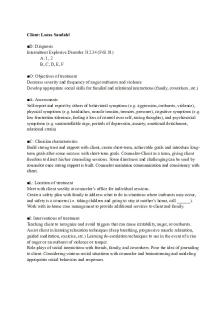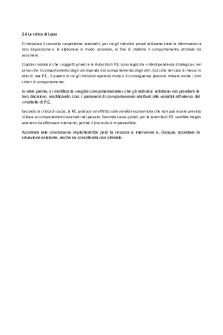Do a Client Map - Lucas Sandahl PDF

| Title | Do a Client Map - Lucas Sandahl |
|---|---|
| Course | Diag & Treatment Plan |
| Institution | Ohio University |
| Pages | 2 |
| File Size | 69.2 KB |
| File Type | |
| Total Downloads | 19 |
| Total Views | 130 |
Summary
Do a Client Map Mandatory Diagnosis and Treatment Assignment...
Description
Client: Lucas Sandahl ■D: Diagnosis Intermittent Explosive Disorder 312.34 (F63.81) A: 1, 2 B, C, D, E, F ■O: Objectives of treatment Decrease severity and frequency of anger outbursts and violence Develop appropriate social skills for familial and relational interactions (family, coworkers, etc.) ■A: Assessments Self-report and report by others of behavioral symptoms (e.g. aggression, outbursts, violence), physical symptoms (e.g. headaches, muscle tension, tremors, pressure), cognitive symptoms (e.g. low frustration tolerance, feeling a loss of control over self, racing thoughts), and psychosocial symptoms (e.g. uncontrollable rage, periods of depression, anxiety, emotional detachment, relational strain) ■C: Clinician characteristics Build strong trust and rapport with client, create short-term, achievable goals and introduce longterm goals after some success with short-term goals. Counselor-Client as a team, giving client freedom to direct his/her counseling sessions. Some directness and challenging can be used by counselor once strong rapport is built. Counselor maintains communication and consistency with client. ■L: Location of treatment Meet with client weekly at counselor’s office for individual sessions. Create a safety plan with family to address what to do in situations where outbursts may occur, and safety is a concern (i.e. taking children and going to stay at mother’s home, call ______). Work with in-home case management to provide additional services to client and family. ■I: Interventions of treatment Teaching client to recognize and avoid triggers that can cause irritability, anger, or outbursts. Assist client in learning relaxation techniques (deep breathing, progressive muscle relaxation, guided meditation, exercise, etc.) Learning de-escalation techniques to use in the event of a rise of anger or an outburst of violence or temper. Role-plays of social interactions with friends, family, and coworkers. Pose the idea of journaling to client. Considering various social situations with counselor and brainstorming and modeling appropriate social behaviors and responses.
■E: Emphasis of treatment Increase awareness of anger expression patterns and triggers Decrease outbursts, irritability, and aggression Increase appropriate expressions of frustration, anger, or stressful emotions Increase development and use of appropriate social skills with family, friends, coworkers, etc. ■N: Number of people to include in treatment Individual counseling sessions with client Consider utilizing in-home case management for work with family as a whole, potentially consider family counseling sessions later in treatment if warranted or desired. ■T: Timing, frequency, pacing and duration of treatment Individual counseling sessions with client once weekly for 50 minutes – plan to continue treatment for 12 weeks, but can be increased as needed ■M: Medications if any needed or already being taken If medication is something the client would like to consider, refer to family physician or psychiatrist for further assessment, information, and treatment. ■A: Adjunct and ancillary services In-home case management services, could utilize a gym, yoga/meditation groups, etc. ■P: Prognosis With successful counseling and implementation of learned social skills, emotional regulation skills, and coping skills, prognosis could be considered good. Further counseling services or case management services could be utilized as needed....
Similar Free PDFs

Do a Client Map - Lucas Sandahl
- 2 Pages

Client Client Conflicts
- 4 Pages

Case Brief - Client - Grade: A
- 6 Pages

LA Critica DI Lucas
- 1 Pages

Mind map - a study guide
- 1 Pages

Resenha do filme do luto a luta
- 3 Pages

Análise do conto a missa do galo
- 4 Pages

A BIBLIA DO ADVPL
- 1 Pages

A obsolescência do homem
- 3 Pages

A fabricação do rei
- 2 Pages
Popular Institutions
- Tinajero National High School - Annex
- Politeknik Caltex Riau
- Yokohama City University
- SGT University
- University of Al-Qadisiyah
- Divine Word College of Vigan
- Techniek College Rotterdam
- Universidade de Santiago
- Universiti Teknologi MARA Cawangan Johor Kampus Pasir Gudang
- Poltekkes Kemenkes Yogyakarta
- Baguio City National High School
- Colegio san marcos
- preparatoria uno
- Centro de Bachillerato Tecnológico Industrial y de Servicios No. 107
- Dalian Maritime University
- Quang Trung Secondary School
- Colegio Tecnológico en Informática
- Corporación Regional de Educación Superior
- Grupo CEDVA
- Dar Al Uloom University
- Centro de Estudios Preuniversitarios de la Universidad Nacional de Ingeniería
- 上智大学
- Aakash International School, Nuna Majara
- San Felipe Neri Catholic School
- Kang Chiao International School - New Taipei City
- Misamis Occidental National High School
- Institución Educativa Escuela Normal Juan Ladrilleros
- Kolehiyo ng Pantukan
- Batanes State College
- Instituto Continental
- Sekolah Menengah Kejuruan Kesehatan Kaltara (Tarakan)
- Colegio de La Inmaculada Concepcion - Cebu





